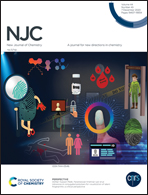Enzyme-free detection of uric acid using hydrothermally prepared CuO·Fe2O3 nanocrystals†
Abstract
Copper oxide doped iron oxide nanocrystals (CuO·Fe2O3 NCs) were prepared using a simple hydrothermal technique at low temperature in an alkaline medium. The CuO·Fe2O3 NCs were characterized by means of conventional techniques such as Fourier transform infrared spectroscopy (FTIR), UV-visible spectroscopy (UV-Vis), powder X-ray diffraction (XRD), field-emission scanning electron microscopy (FESEM) combined with X-ray electron dispersive spectroscopy (XEDS), and X-ray photoelectron spectroscopy (XPS). A sensitive and selective uric acid (UA) sensor was developed with the deposition of a thin-layer of doped NCs onto a flat glassy carbon electrode (GCE, surface area: 0.0316 cm2) using a coating binder. Enhanced analytical performances such as sensitivity, limit of detection (LOD), limit of quantification (LOQ), linear dynamic range (LDR), and long-term stability of the proposed uric acid sensor were achieved by a reliable current–voltage (I–V) system. The calibration curve was found to be linear (R2 = 0.8670) over a broad range of uric acid concentrations (100.0 pM–100.0 mM). The sensitivity, LOD, and LOQ of the proposed uric acid sensor were found to be 3.16 × 10−5 μA μM−1 cm−2, 10.20 ± 1.0 pM, and 340.0 mM, respectively. The expected CuO·Fe2O3 NCs/GCE/Nf sensor was used for real sample analysis to find the uric acid concentration and acceptable results were obtained. This electrochemical approach can be an innovative approach in enzyme-less biosensor development for the assessment of unsafe bio-molecules in the healthcare field.



 Please wait while we load your content...
Please wait while we load your content...